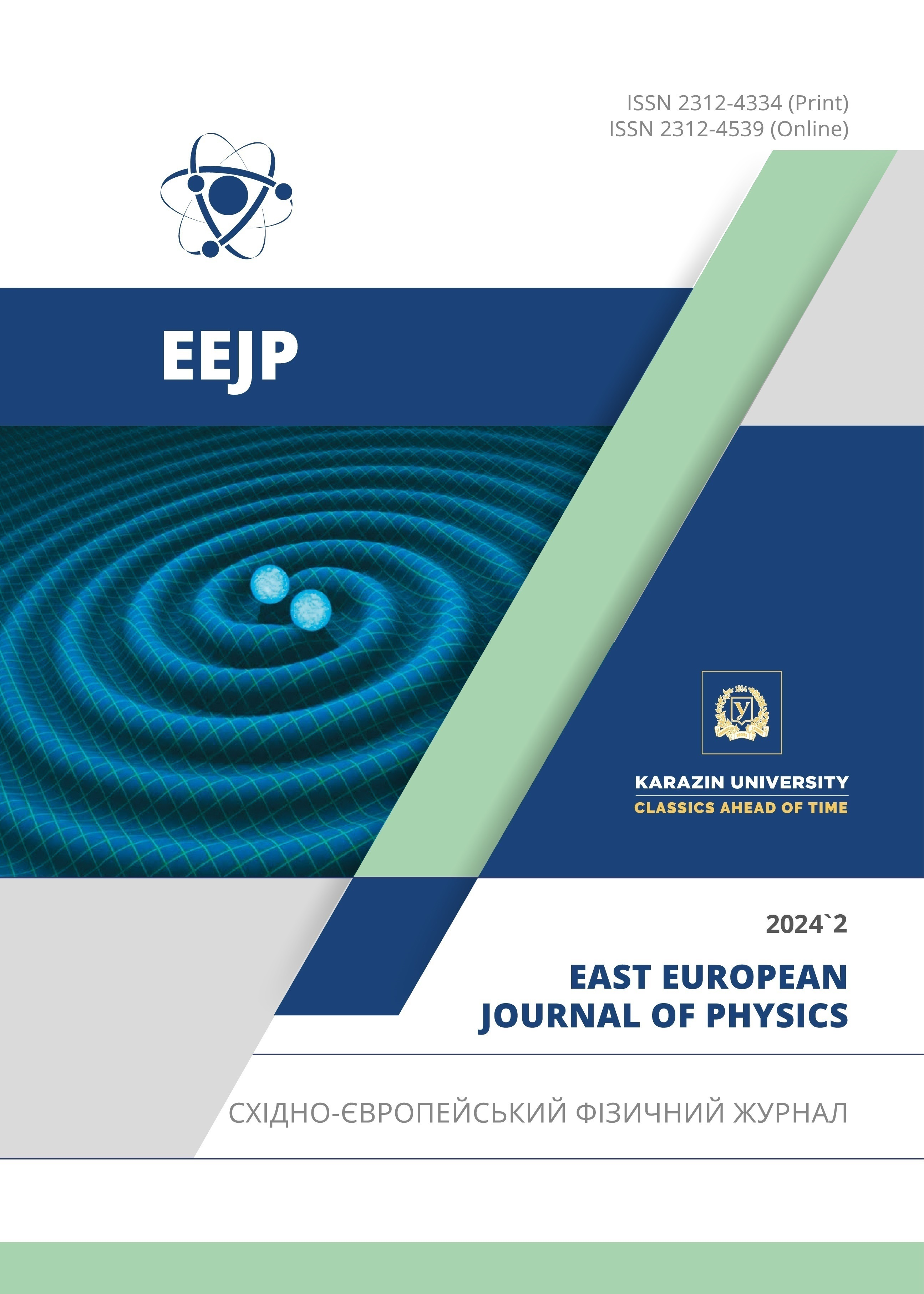Defective Structure of Silicon Doped with Dysprosium
Abstract
In this work, the structural and optical characteristics of silicon (n-Si) samples and its compositions with dysprosium (n-Si-Dy) were analyzed using Fourier transform infrared spectroscopy (FTIR) and Raman spectroscopy methods. Characteristic peaks in the FTIR spectra such as 640 cm-1 (Si-H mode) and 1615 cm-1 (perpendicular stretching mode) were identified, indicating the structural features of the material. The appearance of additional peaks in the n-Si-Dy spectra at 516.71 cm-1 and 805 cm-1 indicates the influence of dysprosium on the structure and defectiveness of the material. Examination of the frequency range (1950–2250 cm-1) further confirms local vibration modes associated with defects and interactions with dysprosium. Peaks associated with Dy-Dy stretching, as well as interaction with silicon, were found at 2110 cm-1 and 2124 cm-1. Analysis of Raman spectra indicates the formation of silicon nanocrystals during annealing, which is confirmed by XRD results. The results obtained provide important insight into the effect of dysprosium on the structure and properties of silicon materials, which could potentially find application in optoelectronics and materials science.
Downloads
References
L.T. Canham, “Silicon quantum wire array fabrication by electrochemical and chemical dissolution of wafers,” Appl. Phys. Lett. 57, 1046-1990. https://doi.org/10.1063/1.103561
F. Huisken, H. Hofmeister, B. Kohn, M.A. Laguna, and V. Paillard, “Laser production and deposition of light-emitting silicon nanoparticles,” Appl. Surf. Sci. 154–155, 305 (2000). https://doi.org/10.1016/s0169-4332(99)00476-6
V. Vinciguerra, G. Franzo, F. Priolo, F. Iacona, and C. Spinella, “Quantum confinement and recombination dynamics in silicon nanocrystals embedded in Si/SiO2 superlattices,”J. Appl. Phys. 87, 8165 (2000). https://doi.org/10.1063/1.373513
F. Koch, and V. Petrova-Koch, “Light from Si-nanoparticle systems - a comprehensive view,”J. Non-Cryst. Solids, 198–200, 840 (1996). https://doi.org/10.1016/0022-3093(96)00067-1
Zh. Ma, X. Liao, J. He, W. Cheng, G. Yue, Y. Wang, and G. Kong, “Annealing behaviors of photoluminescence from SiOx:H,” J. Appl. Phys. 83, 7934 (1998). https://doi.org/10.1063/1.367973
M. Zaharias, H. Freistdt, F. Stolze, T.P. Drusedau, M. Rosenbauer, and M. Stutzmann, “Properties of sputtered a-SiOx:H alloys with a visible luminescence,” J. Non-Cryst. Solids, 164–166, 1089 (1993). https://doi.org/10.1016/0022-3093(93)91188-9
U. Kahler, and H. Hofmeister, “Silicon nanocrystallites in buried SiOx layers via direct wafer bonding,” Appl. Phys. Lett. 75, 641 (1999). https://doi.org/10.1063/1.124467
S. Zhang, W. Zhang, and J. Yuan, “The preparation of photoluminescent Si nanocrystal–SiOx films by reactive evaporation,” Thin Solid Films, 326, 92 (1998). https://doi.org/10.1016/S0040-6090(98)00532-X
H. Richter, Z.P. Wang, and L. Ley, “The one phonon Raman spectrum in microcrystalline silicon,”Solid State Commun. 39, 625 (1981). https://doi.org/10.1016/0038-1098(81)90337-9
Z. Iqbal, and S. Veprek, “Raman scattering from hydrogenated microcrystalline and amorphous silicon,” J. Phys. C, 15, 377 (1982). https://doi.org/10.1088/0022-3719/15/2/019
J. Gonzales-Hernandez, G.H. Azarbayejani, R. Tsu, and F.H. Pollak, “Raman, transmission electron microscopy, and conductivity measurements in molecular beam deposited microcrystalline Si and Ge: A comparative study,”Appl. Phys. Lett. 47, 1350 (1985). https://doi.org/10.1063/1.96277
I.H. Campbell, and P.M. Fauchet, “The effects of microcrystal size and shape on the one phonon Raman spectra of crystalline semiconductors,” Solid State Commun. 52, 739 (1986). https://doi.org/10.1016/0038-1098(86)90513-2
J. Zi, H. Buscher, C. Falter, W. Ludwig, K. Zhang, and X. Xie, “Raman shifts in Si nanocrystals,” Appl. Phys. Lett. 69, 200 (1996). https://doi.org/10.1063/1.117371
D.R. dos Santos, and I.L. Torriany, “Crystallite size determination in μc-Ge films by x-ray diffraction and Raman line profile analysis,” Solid State Commun. 85, 307 (1993). https://doi.org/10.1016/0038-1098(93)90021-E
Kh.S. Daliev, Z.E. Bahronkulov, and J.J. Hamdamov, “Investigation of the Magnetic Properties of Silicon Doped with Rare-Earth Elements,” East Eur. J. Phys. 4, 167 (2023). https://doi.org/10.26565/2312-4334-2023-4-18
Kh.S. Daliev, Sh.B. Utamuradova, Z.E. Bahronkulov, A.Kh. Khaitbaev, and J.J. Hamdamov, “Structure Determination and Defect Analysis n-Si, p-Si Raman Spectrometer Methods,” East Eur. J. Phys. 4, 193 (2023). https://doi.org/10.26565/2312-4334-2023-4-23
P.A. Temple, and C.E. Hathaway, “Multiphonon Raman Spectrum of Silicon,” Physical Review B, 7(8), 3685–3697 (1973). https://doi.org/10.1103/PhysRevB.7.3685
K.J. Kingma, and R.J. Hemley, “Raman spectroscopic study of microcrystalline silica,” American Mineralogist, 79(3-4), 269 273 (1994). https://pubs.geoscienceworld.org/msa/ammin/article-pdf/79/3-4/269/4209223/am79_269.pdf
G.E. Walrafen, Y.C. Chu, and M.S. Hokmabadi, “Raman spectroscopic investigation of irreversibly compacted vitreous silica,” The Journal of Chemical Physics, 92(12), 6987–7002 (1990). https://doi.org/10.1063/1.458239
B. Champagnon, C. Martinet, M. Boudeulle, D. Vouagner, C. Coussa, T. Deschamps, and L. Grosvalet, “High pressure elastic and plastic deformations of silica: in situ diamond anvil cell Raman experiments,” Journal of Non-Crystalline Solids, 354(2-9), 569–573 (2008). https://doi.org/10.1016/j.jnoncrysol.2007.07.079
A.S. Zakirov, Sh.U. Yuldashev, H.J. Wang, H.D. Cho, T.W. Kang, J.J. Khamdamov, and A.T. Mamadalimov, “Photoluminescence study of the surface modified and MEH-PPV coated cotton fibers,” Journal of Luminescence, 131(2), 301–305 (2011). https://doi.org/10.1016/j.jlumin.2010.10.019
Sh.B. Utamuradova, H.J. Matchonov, Zh.J. Khamdamov, and H.Yu. Utemuratova, “X-ray diffraction study of the phase state of silicon single crystals doped with manganese,” New Materials, Connections Oath Applications, 7(2), 93-99 (2023). http://jomardpublishing.com/UploadFiles/Files/journals/NMCA/v7n2/Utamuradova_et_al.pdf
Kh.S. Daliev, Sh.B. Utamuradova, J.J. Khamdamov, M.B. Bekmuratov, “Structural Properties of Silicon Doped Rare Earth Elements Ytterbium,” East Eur. J. Phys. 1, 375-379 (2024). https://doi.org/10.26565/2312-4334-2024-1-37
Copyright (c) 2024 Khodjakbar S. Daliev, Sharifa B. Utamuradova, Alisher Khaitbaev, Jonibek J. Khamdamov, Shahriyor B. Norkulov, Mansur B. Bekmuratov

This work is licensed under a Creative Commons Attribution 4.0 International License.
Authors who publish with this journal agree to the following terms:
- Authors retain copyright and grant the journal right of first publication with the work simultaneously licensed under a Creative Commons Attribution License that allows others to share the work with an acknowledgment of the work's authorship and initial publication in this journal.
- Authors are able to enter into separate, additional contractual arrangements for the non-exclusive distribution of the journal's published version of the work (e.g., post it to an institutional repository or publish it in a book), with an acknowledgment of its initial publication in this journal.
- Authors are permitted and encouraged to post their work online (e.g., in institutional repositories or on their website) prior to and during the submission process, as it can lead to productive exchanges, as well as earlier and greater citation of published work (See The Effect of Open Access).








